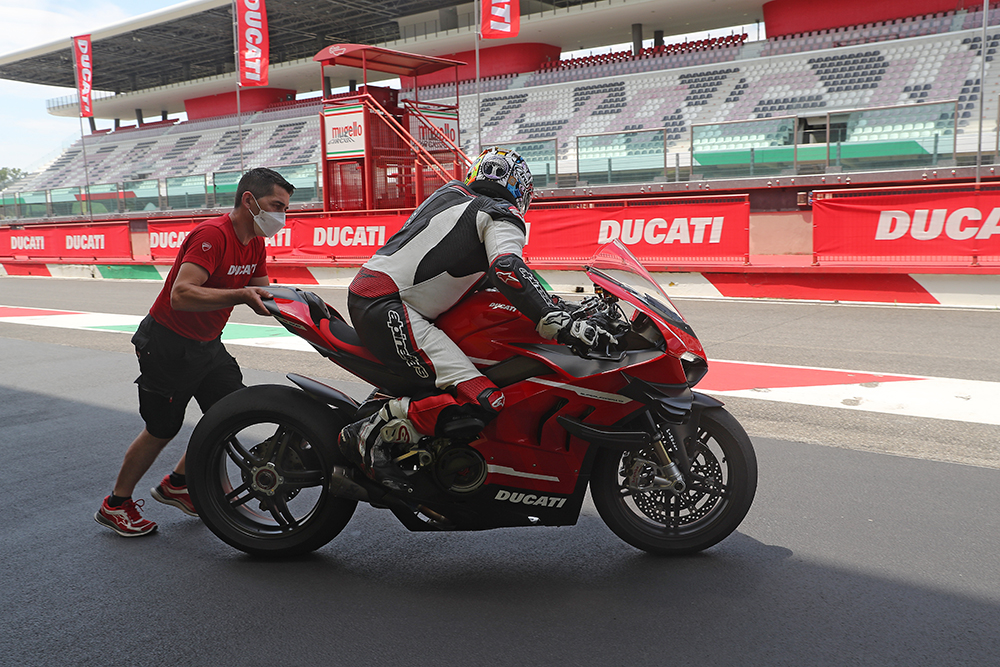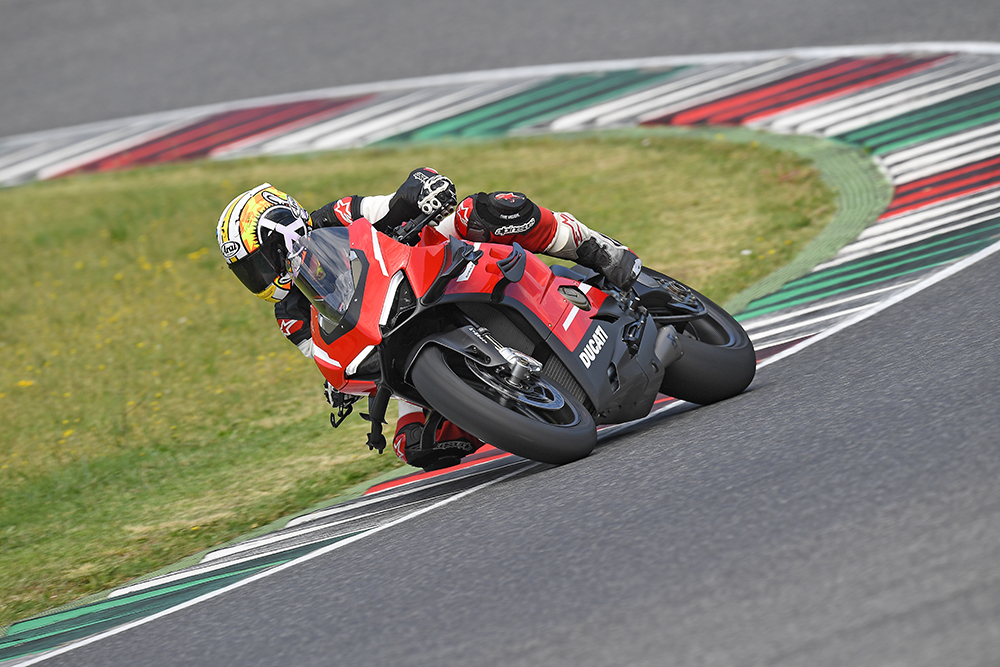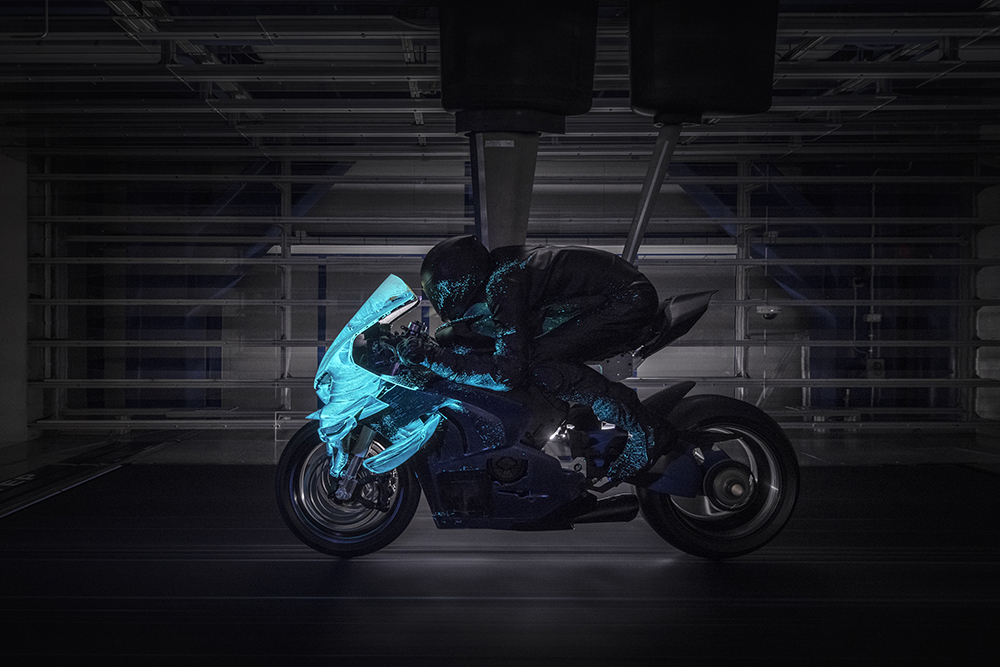Ducati’s Superleggera V4 is lighter than Scott Redding’s factory World Superbike and capable of more downforce than Jack Miller’s MotoGP machine. Oh, and you can ride it around to your mate’s house
WORDS ADAM CHILD PHOTOGRAPHY MILAGRO
The Superleggera is actually lighter than the WorldSBK bike and its huge bi-plane wings create more downforce than even Ducati’s GP20 MotoGP machine. Yet, it has headlights and mirrors, and you can ride it to the shops. Despite its V4 Stradale motor revving to 16,500rpm, service intervals are at a perfectly normal 12,000km.
Two Mugello lap times tell the true story. Michele Pirro, a Moto2 race winner who finished seventh in MotoGP at Mugello in 2019, set a best lap in the Italian Superbike race of 1m50.3s on his race-prepared V4. Meanwhile, Alessandro Valia, the highly skilled Ducati test rider, on the same tyres as Pirro but aboard the Superleggera with a race kit, managed a 1m52.45s. There’s just two seconds in it, and it’s a really long lap. And the Superleggera was running standard gearing and gearbox, road-compound brake pads and so on. Simply by optimising the gearing for the Tuscany track, Valia would have shaved off another second.

So don’t be fooled into thinking this is ‘just’ a Panigale with a race pipe and big wings. Oh no; this is something else indeed. It is, for starters, the world’s only homologated bike with a carbon chassis, which saves 1.2kg over the standard bike and carbon wheels account for another 3.4kg weight saving. The swingarm has less rigidity and more flex, and is 11mm longer than the stocker’s while making a saving of 0.9kg. The subframe, too, is 1.2kg lighter; the bodywork – you guessed it – is carbon, too, and 1100 grams lighter.
The list goes on: Öhlins suspension is 0.6kg lighter courtesy of a titanium rear spring and machined aluminium fork lowers. The rear sprocket nuts are titanium, the sprocket itself is aluminium, the chain is even lighter, making a total saving in this area of 1.4kg. The detailing and dedication take your breath away – seriously – even the suspension linkages and footpegs are machined to be lighter.

Then we get to the 1000cc Stradale V4 taken from the ‘top-spec’ V4 R model, itself an extraordinarily compact and lightweight engine. Somehow though, Ducati engineers shaved 2.8kg, while the road-legal Akrapovic exhaust is 2.5kg lighter than the standard V4 item, and the full race system, which takes power to (174kW) 234hp, saves a whopping six kilograms from standard.
All of which brings the Superleggera to the scales at 159kg. Even with its homologated power output of 224hp (165kW), that’s enough to give it the record-breaking power to weight ratio of 1.41hp/kg.
We’ve mentioned the weight and the power, but they only tell half the story. We also have to discuss the huge bi-plane wings. I was lucky enough to be invited to Bologna, the home of Ducati, to take a sneak preview of the new Superleggera and chat with the engineers earlier in the year. The distinctive and, I would say, attractive wings are fascinating and directly derived from MotoGP.

Back in 2016, there weren’t any restrictions in the size and shape of the wings, which means the GP16, Ducati’s last MotoGP bike before downforce-curbing regulations were introduced, had the most effective wings of all time. In fact, the downforce created by the Superleggera is higher than the GP20, a bike that must conform to strict regulations around size.
At 270km/h, the wings produce 50kg of downforce – 20kg more than the current Panigale with its single wing. At 300km/h that’s up to 61kg – around the same weight as a typical MotoGP rider and a colossal amount of downforce, enough to improve stability and reduce wheelies affording better acceleration, braking and corner entry.
The electronics package is all-new simply because transferring the electronics from the current V4 R to the lighter, more powerful, extra downforce Superlegerra just wouldn’t work. As you’d expect, it gets the full portfolio of goodies: cornering ABS, slide control, traction control, anti-wheelie, launch control, a two-way quickshifter and changeable engine braking strategies. Rider aids can be trimmed and changed to meet personal demands while Ducati has also added three additional new rider modes, simply A, B, and Sport; two are track specific and the third is for the road.

There’s also a new RaceGP dash mode, for track use only, which shows your lap times, splits, and rider aids. Pre-programmed tracks are already saved, like Mugello, so you can simply work on improving your lap time and sector splits.
Every component of the Superleggera has been improved or lightened. The Brembo master cylinder even has a remote adjuster on the left bar, just like a real racebike. The Öhlins suspension is the very latest and uses MotoGP technology, while even the road-legal Pirellis are specially made and come with red sidewalls.
Just arriving at Mugello, one of the greatest tracks in the world, sends shivers down your spine. To also have the privilege of becoming only the second person outside Ducati to sample one, means the pressure is on. Even Claudio Domenicali, the CEO of Ducati, is present – and even he’s not ridden it yet (he’s after me).

Awaiting in a scorching Mugello garage is my Superleggera, lovingly prepared, Pirelli slicks wrapped in tyre warmers. I pre-selected my rider mode – ‘Race B’, which reduces the torque in first and second gear – though I have the option to flick into the full power A mode on the fly.
I’m given the nod to get ready. The engine fires up with a press of the starter button. Ducati has opted for the race exhaust, which means the full 174kW and an intoxicating exhaust note. A few blips of the throttle sends a spine-tingling reverberation around the amphitheatre which is Mugello. I let the engine revs drop, listen to the dry clutch rattle, and give the brake lever span adjuster on the left a quick turn. It’s a conventional down-change into first gear, then clutch out and we’re down pit-lane to join an empty track.
The clutch is now redundant as I fire in a few quick gearchanges towards turn one. The bark between fast gear changes sounds like a gun going off and echoes around the grandstand.

It’s over 30 degrees out here and the Pirelli slicks have been scrubbed in and heated on warmers, so there’s no need to take it steady. Out of turn one, stay to the right ready for the left-right chicane of turns two and three. Immediately the carbon-chassis of the Superleggera wants to turn, feeling light, accurate and fast steering. A similar chicane at turns four and five reveals a change of direction that is simply phenomenal as my knee slider hits both apexes. Out of turn five, I’m recalibrating to sheer intensity of the V4’s power and torque, yet only tickling the throttle… and up to the spectacular Casanova, Savelli, Arrabbiata one and two, arguably one of the most exciting sections of track in the world.
The Ducati drops down Savelli in one fluid movement and holds confidence-inspiring corner speed, then lines up Arrabbiata one and two. This Ducati might have the power of the factory’s WorldSBK contender, or near as damn it, but it’s usable and smooth. I’m a little rusty from the enforced layoff and braking and accelerating at the wrong points, but the bike is allowing me to do so without a hint of complaint.
Around the long turn 12 (Correntaio) for the first time and the Ducati wants to dig in and lean – not a millimetre of drift – and takes the bumps with ease. Now the fast section up to the long and lingering last corner, Bucine, before the long start-finish straight. For the first time I brake reasonably heavily to get the right line, and discover the Brembos are on another level, too, and as strong as any I’ve tested. Seconds later I pick the bike up and head to the outside kerb, finally asking the V4 for full power.

I tuck in behind the sizeable screen, tap the gears, push my arse up against the bump stop and enjoy the ride. The liquid-smooth Stradale motor loves to rev, while upshifts are almost seamless and incredibly quick. Each flick of left foot smacks me in the head with another tidal wave of power.
Yes, Mugello is over five kilometres long but has never felt so short or so fast. I seem to be changing gear every second or so, while the Superleggera’s acceleration isn’t normalising; if anything it’s growing stronger.
Towards the end of the straight there is a famous rise, where MotoGP bikes hit 350km/h. You can take it flat by using the white line of the pit lane exit, hold it flat, and brake at the other side of the crest. As I cross the start-finish I am determined to do all the above but am forced roll out slightly because everything is happening so damn fast.

Into turn one again, this time from sixth gear back to second (as quick as you wish and without the use of a clutch), and again I go for the lever too early for the immense Stylema R stoppers.
Between the two chicanes that follow, I give the throttle a handful and the gear shift light illuminates for the first time, pointing out to me I’ve not yet got close to the redline! Peak power is at 15,250rpm and peak torque at 11,750, but the frictionless V4 will rev even higher to 16,000rpm, while the rev limiter in sixth gear is at a giddy 16,500rpm.
I start to gel with bike and circuit but despite getting into the flow and really starting to make the engine scream, the front end remains planted. In my chosen race B riding mode there’s no hint of a wheelie or instability and feels more like playing an XBox game, in which I can ride with impunity – just dial in a handful of power and drive forward with eye-popping acceleration.

Second time around I drive deep into the final turn, slow it right down, kiss the apex and emerge once more onto that runway of a straight. Now I’m only changing gear when the shift light illuminates, but in no time at all I’m in fifth gear and tap into top before that notorious blind rise.
Fast bikes get famously flighty over the crest, some even weave as the suspension extends, but the winged Superleggera is rock-solid and clearly loving those 60-odd kilos of winged downforce.
Hard on the brakes and back down the gears. The calipers grab the 330mm discs like a great white shark holding onto a seal, yet the forks take the strain, and again the stability is impeccable. The limiting factor isn’t the brakes but the rider. I don’t know of any other bike that can brake this late and remain so planted. From 300km/h back to second gear and the low apex speed of turn one, the Superleggera outperforms any production bike I’ve ridden in over 20 years of testing.
The wings are obviously adding to this stability, but so is the carbon fire chassis, which now has more flex and feel than before. Then there is the brail-like feel from the Öhlins pressurised forks and the grip and larger contact patch generated by the 125-section front Pirelli slick. It’s like the perfect storm, one so potent it’s hard to put into words.

DU 2019-09-25 GALLERIA DEL VENTO
Everyone knew this Superleggera was going to be fast, after all the figures stand out for themselves, but like the braking, I didn’t expect the handling to be so far ahead of the game. Ducati already produces one of the finest handling production bikes on the market, the Ducati Panigale V4 R, yet this is another step forwards.
How do you improve on what already seems like perfection? Ducati has done it. Because the way the Superleggera turns and rolls into corners and changes direction is discernibly new. Brake late, accelerate early, miss your apex or mess up a line – and the Superleggera is there to pick up the pieces. Mid-corner, there’s simply endless grip.
Always in the back of my mind is the bike’s $150,000 price tag and I don’t fancy being the first person to bring a Superleggera back to the pits in shopping bags, especially not in front of the Ducati top brass. Yet the Superleggera’s chassis encourages me to ride harder, to push until it gives some kind of acknowledgement that I am at least making it work a bit.

Thankfully, there is something: the new Desmosedici GP20 derived dashboard (clearly) shows lap time and splits, and each lap it tells me I have broken a personal best. With the booming exhaust chasing and encouraging me further, I revel in the bike’s innate sense of security, happily trying to beat my last PB.
I’ve ridden monstrously powerful WorldSBK Ducatis before and even congratulated Chaz Davies on his bravery after sampling his bike at Imola a few years ago. This Superleggera, however, is incredibly forgiving and easy considering its jaw-dropping power.
As my bravery and confidence improve I opt to flick to A mode, which delivers full power and torque in the lower gears. To be fair, Mugello isn’t a wheelie-happy track (I only used first gear to leave pit-lane) but in this sharper mode there’s certainly more kick lower down. But again the front is unflustered, only lifting slightly on the first application of throttle when the wings aren’t really working at low speeds.

Lap after the lap, the Superleggera continues to impress. Despite such heavy use, the Brembo stoppers showed no sign of fading.
With the chequered flag shown just underneath the gantry, my thrilling ride is over. Interestingly, despite my poor fitness, lack of riding due to the Covid-19 ban, and scorching temperature, I’m far from being on my last legs. It shows despite its snarl and bark, the Superleggera is eminently ridable. Sure, it’s fast but it’s just so manageable.
On the cool-down lap I feel a little emotional. To ride Mugello is always special, but to do so on the new Superleggera is an extra privilege. What a bike, what an experience, one I’ll never forget.

Yes, it’s priced at $150,000 and Ducati is only producing 500 of them. And, sadly, some will never be ridden in anger; instead they will be whisked away into a private collection or bought as future investments. But beyond these negatives I can’t find any faults.
This is a genuine superbike for the road, a machine capable of lapping within a few seconds of a topflight factory racebike that can, incredibly, be ridden on the road, both legally and easily. On top of that, it looks stunning and has a soul and character of its own.
You know what? I’ll get off the fence and pronounce the 2020 Ducati Superleggera the best production bike I’ve ever ridden.
